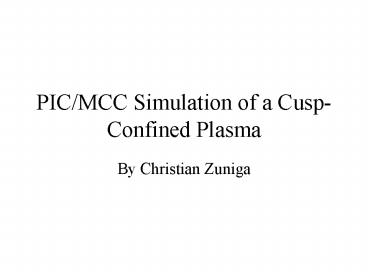PICMCC Simulation of a CuspConfined Plasma - PowerPoint PPT Presentation
1 / 23
Title:
PICMCC Simulation of a CuspConfined Plasma
Description:
Multi-polar cusps now used to confine lower temperature plasmas for ... Leap-frog Integrator (2nd order accurate) Separate electric and magnetic forces (Boris) ... – PowerPoint PPT presentation
Number of Views:35
Avg rating:3.0/5.0
Title: PICMCC Simulation of a CuspConfined Plasma
1
PIC/MCC Simulation of a Cusp-Confined Plasma
- By Christian Zuniga
2
Overview
- Background on cusp-confined plasmas
- Previous simulation of the system
- Method of solution of PIC program
- Conclusions
3
Introduction Magnetic Cusps
- First used as a possible confinement system for
thermonuclear plasmas - - MHD stability at high ß
- - High particle loss rate through the cusps
- Multi-polar cusps now used to confine lower
temperature plasmas for ion-beam sources and
basic plasma studies - Particle leak-width at the cusp is still not well
understood
4
Cusp Leak-Width
- Both experiments and theories disagree on the
size of the leak-width - - 2
- -
- The leak-width has been attributed to numerous
electrostatic, collision, and turbulence effects
5
Previous Computer Simulation
- In the early 80s, Marcus, Knorr, and Joyce made a
PIC program to simulate a plasma in a periodic
picket fence. - Program characteristics
- - 2 dimensional (drifts neglected)
- - Wire spacing 16 real length
- - 64-256
- - Collisionless low-ß plasma
6
Simulation Results
- Relatively good agreement with experiments by
Hershkowitz - - Development of a quasi-steady state
- - Absence of any violent instabilities
- - Development of a deep potential channel
between the wires - - Occurrence of potential hills in front of the
wires - - Effective leak-width on the order of the
hybrid radius (inconclusive)
7
Motivation for PIC/MCC Simulation
- Electrostatic effects are believed to be
important in the confinement of ions - Electrostatic effects are thought to affect the
leak width. - Collisional effects also affect the leak width
8
Computer Model
- Electrostatic approximation
- Deals with high frequencies and small space
scales on the order of the Debye length - Currents presumed small so that the self magnetic
field is small - Equations to solve for
9
Computation Cycle
10
Field Equations
- 5 pt difference approximation to Poissons
equation solved in a 2 dim mesh using the FACR(1)
algorithm by Hockney. The error term is - higher order terms
- FACR algorithm is part of a class of algorithms
(RES) that use direct methods to obtain the exact
solution to a set of Ng difference equations in a
number of ops proportional to (or better) and
have a storage requirement proportional to Ng
11
Poisson Solver
12
Poisson Solver (Steps 1-2)
- Elimination of the odd lines
- Fourier Analysis on even lines only
13
Poisson Solver (Step 3)
- Solution of harmonics by recursive cyclic
reduction
14
Poisson Solver (Steps 4-6)
- Fourier synthesis to find the potential on the
even lines - Charge modification on the odd lines
- Solution on the odd lines by recursive cyclic
reduction
15
Weighting
- Charge interpolation and field interpolation use
the same weighting scheme to conserve momentum by
avoiding the self-force - For linear interpolation in 2 dimensions
16
Lorentz Force Integrator
- Leap-frog Integrator (2nd order accurate)
- Separate electric and magnetic forces (Boris)
17
Monte Carlo Collisions
- Plasma neutral collisions (Burger)
- Probability of a collision for each particle
traveling with velocity v(t) in a time interval
DT - Determine in a random manner which particles
will suffer a collision. - Determine the velocities of the particle after a
collision - Use of null-collision method (Boeuf and Marode)
to speed up calculations.
18
Diagnostics
- Energy calculation
- Snapshots of the potential, particle positions
and velocities - Record of particles escaping the system in the
cusp region
19
Collision and Heating Times (Hockney)
- The collision time gives an estimate of the time
for which the simulation can be run before
collisional effects become important. - The heating time is a measure of the failure of
conservation of energy in the computer model.
20
Particle Loading
- Electrons and ions loaded with a Maxwellian
velocity distribution for each and are uniformly
distributed in the upper area. Te/Ti 4-8
Te1-4 eV - Velocities calculated from
21
Computer Quantities
- Charge to mass ratio preserved, but the charge
contribution from each particles is obtained from
22
Particle Handling
- Particles crossing a periodic boundary are placed
an equal distance on the opposite boundary but
with their z velocity reversed - Particles crossing the upper boundary are
reflected - Particles crossing the lower boundary are
counted. The electrons are replaced less
frequently than the ions.
23
Conclusions
- Presently the program is collisionless and is
giving promising results - Will also solve Poissons equation with the BC in
y reversed. - Collisions need to be added.
- Program requires further optimization































